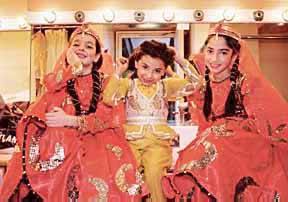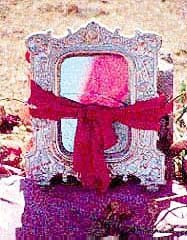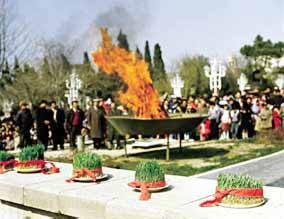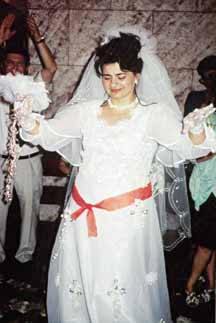|
Summer 1997 (5.2)  Red - If Colors Could Speak  If colors could speak, then red would do the talking in Azerbaijan. Red is a symbol for happiness, passion, festivity and life. Even the name of Azerbaijan reminds you of red because it means "Land of Fire." Imagine brilliant red flames dancing out of the ground and never dying out. This has been happening in Azerbaijan for hundreds of years in places where natural gas escapes through crevices deep inside the earth and seeps up to the surface. It is impossible to put these fires out. So, even the land of Azerbaijan is red!
Archeologists have found traces of red dye in pottery that is more than 5,000 years old. About 2,500 years ago, the ancient Greek writer Herodotus noted that people used a substance from trees in the forests of the Caucasus for dying their clothes red. Today, Azerbaijanis still weave red into their carpets. It's one of their favorite colors for decorating their homes. People believe red protects them. Red is one of the three main
colors found in Azerbaijan's new flag. Red means freedom, but
signifies blood since people often have to die in their fight
for freedom. The other two colors of the flag are green and blue.
Blue is associated with ancient Turks who believed that God was
the blue sky. Green refers to the religion of Islam.
The grandest celebration of the year in Azerbaijan is called Noruz (pronounced NO-ruz), meaning "New Year." It comes on the first day of spring, March 20 or 21, depending on the year. About two weeks earlier, Azerbaijanis start to grow wheat on a plate. They watch over it carefully and water the seeds everyday. When the wheat starts to grow, it looks like grass. Then, they usually tie it with a red ribbon to make it look festive.
Also, on the last Wednesday before Noruz, boys build bonfires in the streets and then run and jump over them. They have to be careful not to stumble and fall into the fire, or they could get burned. They make a wish for all the bad and evil things that happened during the past year to go away, so that they can start the new year fresh and clean. People sometimes say in English that someone is "red in the face" or "red-faced." That means they are embarrassed or blushing. In Azerbaijan, the expression is very different. A person who is "red" is someone who will tell you the absolute truth, even to the point of hurting you with their words. But this is considered very rude in Azerbaijan. People don't like to offend others.
Red is used on Wedding dresses. A red sash is tied around the bride's waist. Red also plays an important
role at funerals. Red ribbons and red baubles decorate many graves
these days. Red means a young person has died who never had the
chance to get married. It's as if the family wants the young
person to "see the red" and happiness that he or she
missed out on. Sometimes at the grave site, a red ribbon will
be wrapped around a broken mirror. There are many graves these
days covered with red, because many young men have died in the
Nagorno-Karabakh conflict. From Azerbaijan International
(5.2)
Summer 1997. Back to Index
AI 5.2 (Summer 1997) |




